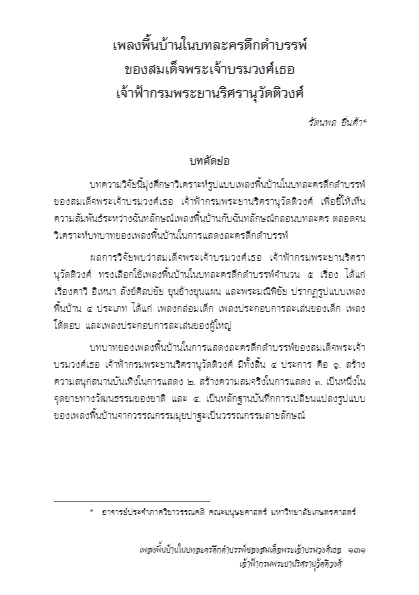รัตนพล ชื่นค้า
บทคัดย่อ
บทความวิจัยนี้มุ่งศึกษาวิเคราะห์รูปแบบเพลงพื้นบ้านในบทละครดึกดำบรรพ์ของสมเด็จพระเจ้าบรมวงศ์เธอ เจ้าฟ้ากรมพระยานริศรานุวัดติวงศ์ เพื่อชี้ให้เห็นความสัมพันธ์ระหว่างฉันทลักษณ์เพลงพื้นบ้านกับฉันทลักษณ์กลอนบทละคร ตลอดจนวิเคราะห์บทบาทของเพลงพื้นบ้านในการแสดงละครดึกดำบรรพ์
ผลการวิจัยพบว่าสมเด็จพระเจ้าบรมวงศ์เธอ เจ้าฟ้ากรมพระยานริศรานุวัดติวงศ์ ทรงเลือกใช้เพลงพื้นบ้านในบทละครดึกดำบรรพ์จำนวน ๕ เรื่อง ได้แก่เรื่องคาวี อิเหนา สังข์ศิลปชัย ขุนช้างขุนแผน และพระมณีพิชัย ปรากฏรูปแบบเพลงพื้นบ้าน 4 ประเภท ได้แก่ เพลงกล่อมเด็ก เพลงประกอบการละเล่นของเด็ก เพลงโต้ตอบ และเพลงประกอบการละเล่นของผู้ใหญ่
บทบาทของเพลงพื้นบ้านในการแสดงละครดึกดำบรรพ์ของสมเด็จพระเจ้าบรมวงศ์เธอ เจ้าฟ้ากรมพระยานริศรานุวัดติวงศ์ มีทั้งสิ้น 4 ประการ คือ 1. สร้างความสนุกสนานบันเทิงในการแสดง 2. สร้างความสมจริงในการแสดง 3. เป็นหนึ่งในจุดขายทางวัฒนธรรมของชาติ และ 4. เป็นหลักฐานบันทึกการเปลี่ยนแปลงรูปแบบของเพลงพื้นบ้านจากวรรณกรรมมุขปาฐะเป็นวรรณกรรมลายลักษณ์
(ตีพิมพ์ใน วารสารไทยศึกษา ปีที่ 9 ฉบับที่ 2 (สิงหาคม 2556 – มกราคม 2557) หน้า 131-160)
Folk Music in the Classical Dance Drama of H.R.H. Prince Narisaranuvattiwongse
Rattanaphon Chuenka
Abstract
The purpose of this research includes the exploration and analysis of folk music patterns in the classical dance dramas or “Lakorn Duekdamban” of H.R.H. Prince Narisaranuvattiwongse in order to explore the relationship of poetic forms between folk music and verse drama and analyze the role of folk music in the classical dance dramas.
According to the research findings, H.R.H. Prince Narisaranuvattiwongse used folk music in five classical dance dramas, Khawi, Inao, Sangsilpachai, Khun Chang Khun Phaen and Phra Maniphichai. In this regard, four patterns of folk music can be found: lullabies, songs for children’s plays, dialogue songs and songs for adult plays.
In addition the folk music used in the classical dance dramas of H.R.H. Prince Narisaranuvattiwongse has four roles: 1) to create enjoyment and amusement of the performance, 2) to enhance the realness of the performance, 3) to present national cultural uniqueness, and 4) to mark the change of folk music from oral to written literature.
(Published in Journal of Thai Studies Volume 9 Number 2 (August 2013 – January 2014) Page 131-160)
บทความ / Full Text : Download
